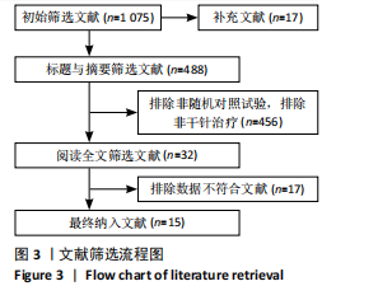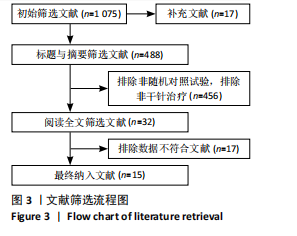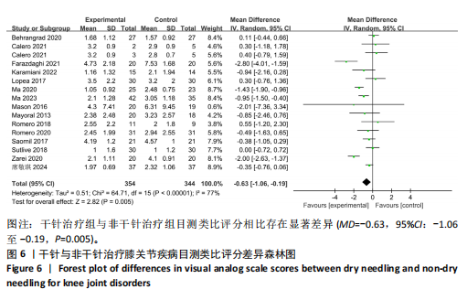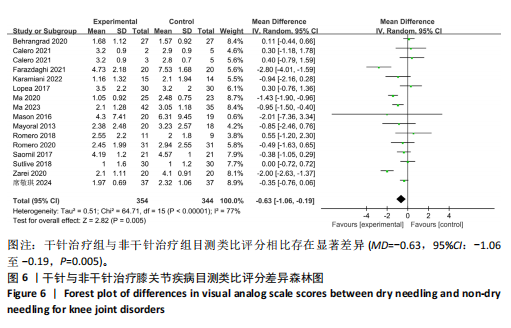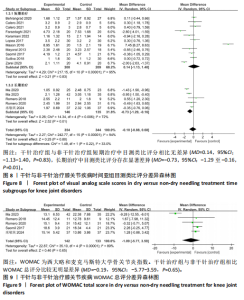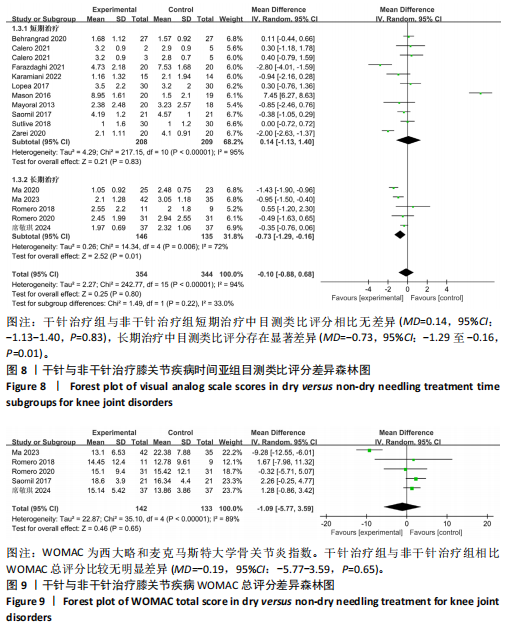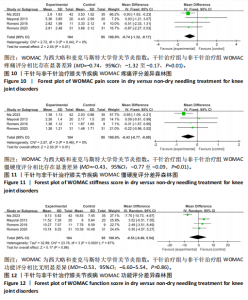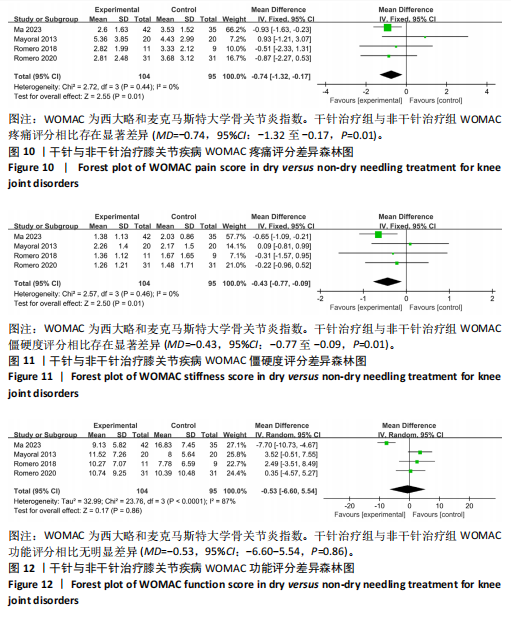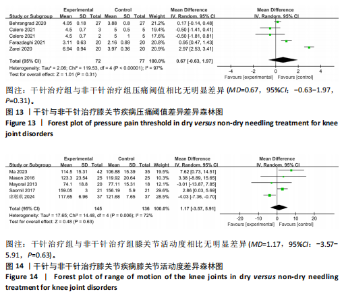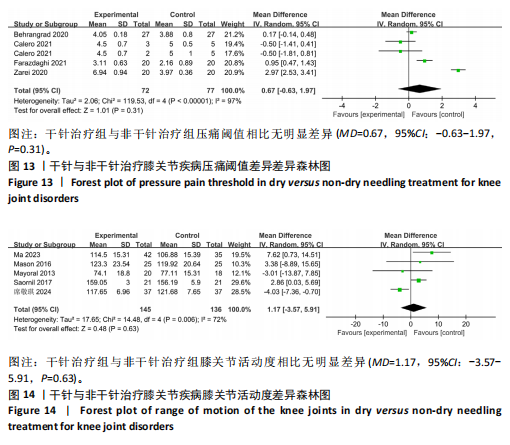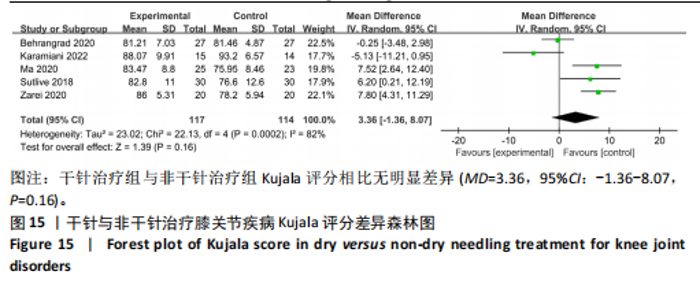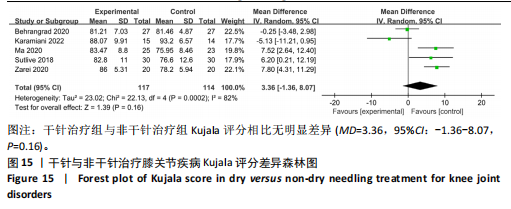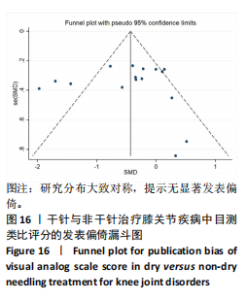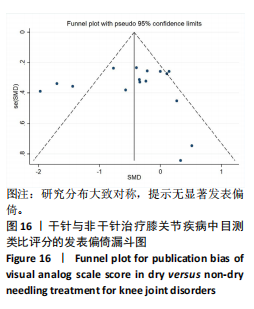Chinese Journal of Tissue Engineering Research ›› 2025, Vol. 29 ›› Issue (32): 6989-6996.doi: 10.12307/2025.920
Previous Articles Next Articles
Meta-analysis of the effectiveness of dry needling at myofascial trigger points in the treatment of knee disorders
Yao Tingfeng, Liu Lin, Liu Shixuan, Lu Xinyue
- School of Sport and Health, Nanjing Sport Institute, Nanjing 210014, Jiangsu Province, China
-
Received:2024-10-11Accepted:2024-11-30Online:2025-11-18Published:2025-04-29 -
Contact:Liu Lin, PhD, Associate professor, School of Sport and Health, Nanjing Sport Institute, Nanjing 210014, Jiangsu Province, China -
About author:Yao Tingfeng, School of Sport and Health, Nanjing Sport Institute, Nanjing 210014, Jiangsu Province, China -
Supported by:National Natural Science Foundation of China, No. 32000829 (to LL)
CLC Number:
Cite this article
Yao Tingfeng, Liu Lin, Liu Shixuan, Lu Xinyue. Meta-analysis of the effectiveness of dry needling at myofascial trigger points in the treatment of knee disorders[J]. Chinese Journal of Tissue Engineering Research, 2025, 29(32): 6989-6996.
share this article
Add to citation manager EndNote|Reference Manager|ProCite|BibTeX|RefWorks
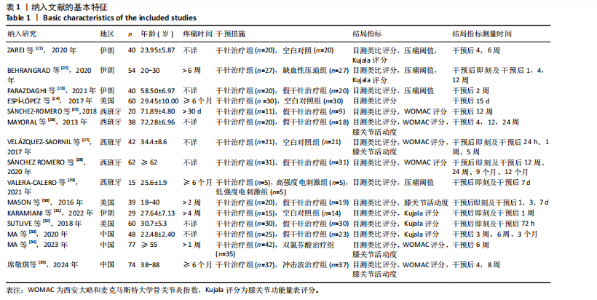
除无关文献,获得出488篇相关文章,进一步剔除不相关信息后获得32篇文献,排除不符数据的文献后,最终纳入15篇相关文献。 2.2 纳入研究的临床特征 共纳入15项研究[21-34],涉及698例患者,其中干针治疗组354例,非干针治疗组344例,见表1。有9项研究为近5年内发表[21-23,28-29,31,33-35],14项研究为近10年内发表[21-25,27-35]。有8项显示患者膝关节疼痛时间超过1 周[22,24-25,29-31,34-35],其余研究的患者疼痛时间不详。 2.3 文献质量评价结果 有2项研究的随机分配和分配隐藏方法不充分或不明确[27,34],所有研究均没有对患者和治疗师同时采用盲法,实施偏倚均为高风险;有5项研究的测量偏倚风险不明确[25-27,32,35],其余研究为的测量偏倚为低风险;纳入研究的其他偏倚风险非常低(如数据完整性、选择性报告、基线可比性等),见图4,5。 2.4 Meta分析结果 2.4.1 目测类比评分 共15项研究对干针治疗组和非干针治疗组目测类比评分进行比较[21-35]。经χ2检验,研究间异质性较高(I2=77%,P < 0.000 01),采用随机效应模型进行分析,结果显示干针治疗组目测类比评分与非干针治疗组相比有明显优势(MD=-0.63,95%CI:-1.06至-0.19,P=0.005),见图6所示。剔除ZAREI等[21]和MA 等[33]的研究后,研究间异质性显著降低(I2=57%,P=0.04),采用随机效应模型进行分析,结果显示干针治疗组目测类比评分与非干针治疗组相比有明显优势(MD=-0.40,95%CI:-0.70至-0.02,P=0.04),分"
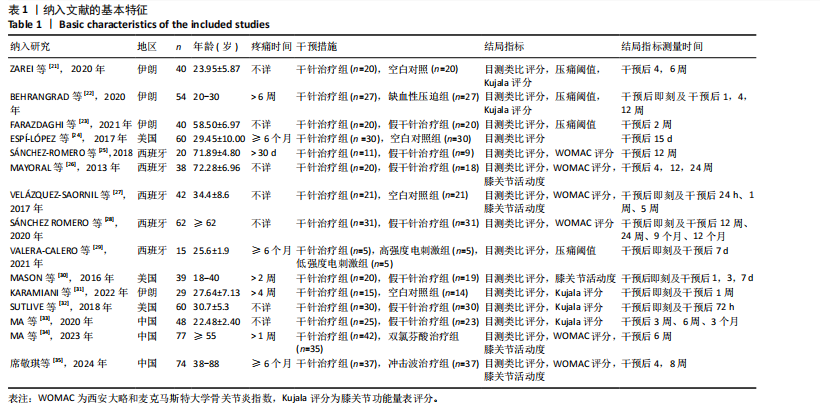
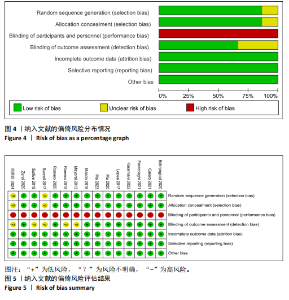
析原因可能为ZAREI等[21]研究纳入患者全部为女性,MA 等[33]的研究缺乏对患者肌肉拉伸的自我监督,从而影响了测量结果。 2.4.2 目测类比评分亚组分析 将非干针治疗组分为假干针治疗组/空白对照组和其他治疗方法组(如缺血性压迫、经皮电刺激、双氯芬酸钠、冲击波等),根据不同的治疗时间进行区分,时间≤1个月为短期治疗,时间> 1个月为长期治疗。 根据不同的治疗方式分为:干针治疗组与假干针治疗/空白对照组、干针治疗组与其他治疗方法组。经χ2 检验,逐一剔除文献后研究间异质性仍较高(I2 > 50%),采用随机效应模型进行分析,结果显示干针治疗组目测类比评分与假干针治疗/空白对照组相比有明显优势(MD=-0.87,95%CI:-1.47至-0.27,P=0.004),干针治疗组与其他治疗方法组目测类比评分对比无明显差异(MD=-0.25,95%CI:-0.72至0.22,P=0.30),见图7。 根据治疗时间分为短期治疗和长期治疗。经χ2 检验,研究间异质性较高,逐一剔除文献后研究间异质性仍较高(I2 > 50%),采用随机效应模型分析,结果显示干针治疗组与非干针治疗组短期治疗中目测类比评分相比无差异(MD=0.14,95%CI:-1.13至1.40,P=0.83),长期治疗中干针治疗组目测类比评分与非干针治疗组相比有明显优势(MD=-0.73,95%CI:-1.29至-0.16,P=0.01),见图8。 2.4.3 WOMAC评分 共5项研究对干针治疗组和非干针治疗组WOMAC总评分进行比较[25,27-28,34-35]。经χ2 检验,研究间异质性较高(I2=89%,P < 0.000 01),采用随机效应模型进行分析,结果显示两组间WOMAC总评分相比无明显差异(MD=-0.19,95%CI:-5.77至3.59,P=0.65),见图9。剔除MA等[34]的研究后,研究间异质性明显降低 (I2=0%,P=0.84),采用固定效应模型进行分析,结果显示干针治疗组WOMAC总评分与非干针治疗组相比有明显优势(MD=1.53,95%CI:-0.01至3.07,P=0.05),分析原因可能为患者年龄太大身体活动能力严重受限,进而影响了WOMAC总评分。 共4项研究对干针治疗组和非干针治疗组WOMAC疼痛评分、WOMAC僵硬度评分和WOMAC功能评分进行比较[25-26,28,34]。经过χ2 检验,WOMAC疼痛评分、 WOMAC僵硬度评分研究间的异质性较低(I2=0%,P=0.44;I2=0%,P=0.46),采用固定效应模型进行分析,结果显示干针治疗组WOMAC疼痛评分、WOMAC 僵硬度评分与非干针治疗组相比有明显优势(MD=0.-74,95%CI:-1.32至-0.17,P=0.01;MD=-0.43,95%CI:-0.77至-0.09,P=0.01),见图10,11。经过χ2 检验,WOMAC功能评分研究间异质性较高( I2=87%,P < 0.000 1),采用随机效应模型进行分析,结果显示两组间WOMAC功能评分相比无明显差异(MD=-0.53,95%CI:-6.60至5.54,P=0.86),见图12。剔除MA等[34]的研究后,WOMAC 功能评分研究间异质性明显降低 (I2=0%,P=0.62),采用固定效应模型进行分析,结果显示两组间WOMAC功能评分相比无明显差异(MD=2.30,95%CI:-0.47至5.05,P=0.10),分析原因可能为患者年龄太大身体活动能力严重受限,进而影响了WOMAC功能评分。 2.4.4 压痛阈值 共4项研究对干针治疗组与非干针治疗组压痛阈值进行比较[21-23,29]。经过χ2 检验,研究间异质性较高(I2=97%,P < 0.000 01),采用随机效应模型进行分析,结果显示两组间压痛阈值相比无明显差异(MD=0.67,95%CI:-0.63至1.97,P=0.31),见图13。剔除ZAREI等[21]和FARAZDAGHI等[23] 的研究后,研究间异质性明显降低 (I2=25%,P=0.27),采用固定效应模型进行分析,结果显示两组间压痛阈值相比无明显差异(MD=0.07,95%CI:-0.21-0.36,P=0.62),分析原因可能为ZAREI等[21]和FARAZDAGHI等[23] 研究纳入的全部为女性患者而影响了压痛阈值的测量"
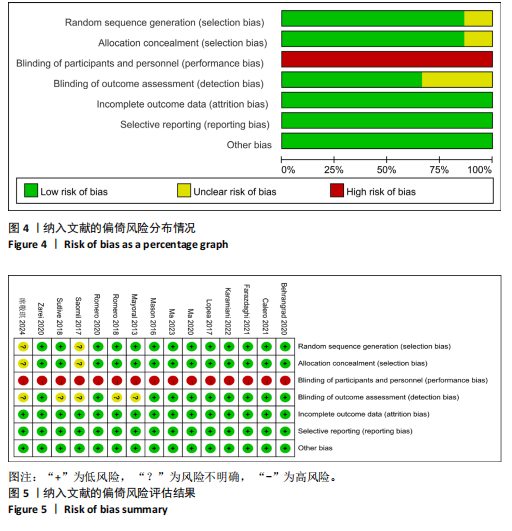
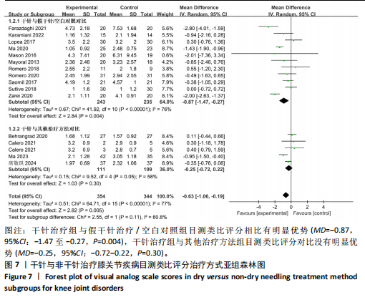
结果。但逐个剔除文献后结果无实质性改变,说明此结果较稳定。 2.4.5 膝关节活动度 共5项研究对干针治疗组与非干针治疗组膝关节活动度进行比较[26-27,30,34-35]。经χ2 检验,研究间异质性较高(I2=72%,P=0.006),采用随机效应模型进行分析,结果显示两组间膝关节活动度相比无明显差异(MD=1.17,95%CI: -3.57-5.91,P=0.63),见图14。剔除席敬琪等[35]的研究后,研究间异质性明显降低 (I2=0%,P=0.41),采用固定效应模型进行分析,结果显示干针治疗组膝关节活动度与非干针治疗组相比有明显优势(MD=3.2,95%CI:0.70-5.69,P=0.01),分析原因可能为纳入患者的膝关节功能严重受损而影响了关节活动度测量结果。 2.4.6 Kujala 评分 共5项研究对干针治疗组与非干针治疗组Kujala评分进行比较[21-22,31-33]。经χ2 检验,研究间的异质性较高(I2=82%,P=0.000 2),逐一剔除文献后I2仍> 50%,采用随机效应模型进行分析,结果显示两组间Kujala评分相比无明显差异(MD=3.36,95%CI:-1.36至8.07,P=0.16),见图15。 2.4.7 发表偏倚检验 对目测类比评分采用漏斗图和 Egger’s 检验进行发表偏倚检测,结果显示研究分布大致对称,提示无显著发表偏倚,见图16。"
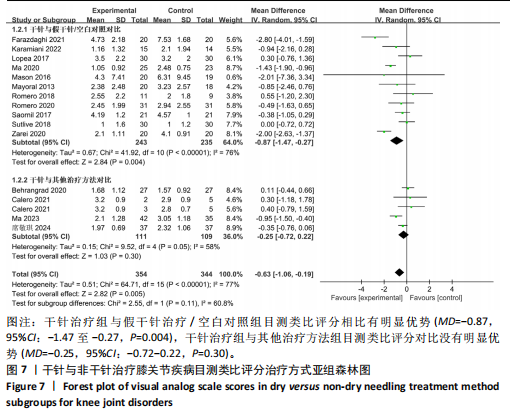
| [1] CHANG AH, ALMAGOR O, LEE JJ, et al. The Natural History of Knee Osteoarthritis Pain Experience and Risk Profiles. J Pain. 2023;24(12):2175-2185. [2] SEOANE-MATO D, SÁNCHEZ-PIEDRA C, SILVA-FERNÁNDEZ L, et al. Prevalence of rheumatic diseases in adult population in Spain (EPISER 2016 study): Aims and methodology. Reumatol Clin (Engl Ed). 2019;15(2):90-96. [3] 王声雨,林源,陶树清.中老年人膝骨关节炎的影响因素分析[J].中国医药导报,2021,18(27):80-83. [4] MICHAEL JW, SCHLÜTER-BRUST KU, EYSEL P. The epidemiology, etiology,diagnosis, and treatment of osteoarthritis of the knee. Dtsch Arztebl Int. 2010;107(9):152-162. [5] 吴园园,郑拥军.肌筋膜疼痛触发点在膝骨性关节炎中作用的研究进展[J].老年医学与保健,2019,25(5):679-682. [6] BARBERO M, SCHNEEBELI A, KOETSIER E, et al. Myofascial pain syndrome and trigger points: evaluation and treatment in patients with musculoskeletal pain. Curr Opin Support Palliat Care. 2019;13(3):270-276. [7] LIU L, HUANG QM, LIU QG, et al. Relationship between muscle spindles and myofascial trigger spots according to Hoffmann reflex pathway and tissue morphology characteristics in a rat model. Acupunct Med. 2020;38(2):109-116. [8] LIU L, HUANG QM, LIU QG, et al. Evidence for Dry Needling in the Management of Myofascial Trigger Points Associated With Low Back Pain: A Systematic Review and Meta-Analysis. Arch Phys Med Rehabil. 2018;99(1):144-152.e2. [9] 郑兵,朱江,吴雪莲,等.针刺肌筋膜触发点在疼痛治疗中的研究进展[J].中国康复医学杂志, 2022,37(1):117-120. [10] FERNÁNDEZ-DE-LAS-PEÑAS C, NIJS J. Trigger point dry needling for the treatment of myofascial pain syndrome: current perspectives within a pain neuroscience paradigm. J Pain Res. 2019;12:1899-1911. [11] 孙定炯.肌筋膜疼痛触发点与传统经络穴位异同点的思考[J].海南医学院学报,2020,26(17): 1358-1360. [12] STOOP R, CLIJSEN R, LEONI D, et al. Evolution of the methodological quality of controlled clinical trials for myofascial trigger point treatments for the period 1978-2015: A systematic review. Musculoskelet Sci Pract. 2017;30:1-9. [13] SZIKSZAY TM, ADAMCZYK WM, CARVALHO GF, et al. Association between myofascial trigger point therapy and conditioned pain modulation. J Bodyw Mov Ther. 2024;38:73-80. [14] KOSZALINSKI A, FLYNN T, HELLMAN M, et al. Trigger point dry needling, manual therapy and exercise versus manual therapy and exercise for the management of Achilles tendinopathy: a feasibility study. J Man Manip Ther. 2020;28(4):212-221. [15] RAHOU-EL-BACHIRI Y, NAVARRO-SANTANA MJ, GÓMEZ-CHIGUANO GF, et al. Effects of Trigger Point Dry Needling for the Management of Knee Pain Syndromes: A Systematic Review and Meta-Analysis. J Clin Med. 2020;9(7):2044. [16] LIN X, LI F, LU H, et al. Acupuncturing of myofascial pain trigger points for the treatment of knee osteoarthritis: A systematic review and meta-analysis. Medicine (Baltimore). 2022;101(8): e28838. [17] JIMÉNEZ-DEL-BARRIO S, MEDRANO-DE-LA-FUENTE R, HERNANDO-GARIJO I, et al. The Effectiveness of Dry Needling in Patients with Hip or Knee Osteoarthritis: A Systematic Review and Meta-Analysis. Life (Basel). 2022;12(10):1575. [18] DOMMERHOLT J, HOOKS T, CHOU LW, et al. A critical overview of the current myofascial pain literature - November 2018. J Bodyw Mov Ther. 2019;23(1):65-73. [19] FURLAN AD, MALMIVAARA A, CHOU R, et al. 2015 Updated Method Guideline for Systematic Reviews in the Cochrane Back and Neck Group. Spine (Phila Pa 1976). 2015;40(21):1660-1673. [20] 杨晓妍,李鸿浩.知证卫生决策工具附件:评估设计的优缺点选录(文18附件3)[J].中国循证医学杂志,2010,10(6):648-649. [21] ZAREI H, BERVIS S, PIROOZI S, et al. Added Value of Gluteus Medius and Quadratus Lumborum Dry Needling in Improving Knee Pain and Function in Female Athletes With Patellofemoral Pain Syndrome: A Randomized Clinical Trial. Arch Phys Med Rehabil. 2020;101(2):265-274. [22] BEHRANGRAD S, ABBASZADEH-AMIRDEHI M, KORDI YOOSEFINEJAD A, et al. Comparison of dry needling and ischaemic compression techniques on pain and function in patients with patellofemoral pain syndrome: a randomised clinical trial. Acupunct Med. 2020;38(6):371-379. [23] FARAZDAGHI M, KORDI YOOSEFINEJAD A, ABDOLLAHIAN N, et al. Dry needling trigger points around knee and hip joints improves function in patients with mild to moderate knee osteoarthritis. J Bodyw Mov Ther. 2021;27:597-604. [24] ESPÍ-LÓPEZ GV, SERRA-AÑÓ P, VICENT-FERRANDO J, et al. Effectiveness of Inclusion of Dry Needling in a Multimodal Therapy Program for Patellofemoral Pain: A Randomized Parallel-Group Trial. J Orthop Sports Phys Ther. 2017;47(6):392-401. [25] SÁNCHEZ-ROMERO EA, PECOS-MARTÍN D, CALVO-LOBO C, et al. Effects of dry needling in an exercise program for older adults with knee osteoarthritis: A pilot clinical trial. Medicine (Baltimore). 2018; 97(26):e11255. [26] MAYORAL O, SALVAT I, MARTÍN MT, et al. Efficacy of myofascial trigger point dry needling in the prevention of pain after total knee arthroplasty: a randomized, double-blinded, placebo-controlled trial. Evid Based Complement Alternat Med. 2013;2013:694941. [27] VELÁZQUEZ-SAORNIL J, RUÍZ-RUÍZ B, RODRÍGUEZ-SANZ D, et al. Efficacy of quadriceps vastus medialis dry needling in a rehabilitation protocol after surgical reconstruction of complete anterior cruciate ligament rupture. Medicine (Baltimore). 2017;96(17):e6726. [28] SÁNCHEZ ROMERO EA, FERNÁNDEZ-CARNERO J, CALVO-LOBO C, et al. Is a Combination of Exercise and Dry Needling Effective for Knee OA? Pain Med. 2020;21(2):349-363. [29] VALERA-CALERO JA, SÁNCHEZ-MAYORAL-MARTÍN A, VAROL U. Short-term effectiveness of high- and low-intensity percutaneous electrolysis in patients with patellofemoral pain syndrome: A pilot study. World J Orthop. 2021;12(10):781-790. [30] MASON JS, CROWELL M, DOLBEER J, et al. The effectiveness of dry needling and stretching vs. stretching alone on hamstring flexibility in patients with knee pain: a randomized controlled trial. Int J Sports Phys Ther. 2016;11(5):672-683. [31] KARAMIANI F, MOSTAMAND J, RAHIMI A, et al. The Effect of Gluteus Medius Dry Needling on Pain and Physical Function of Non-athlete women with Unilateral Patellofemoral Pain Syndrome: A Double-Blind Randomized Clinical Trial. J Bodyw Mov Ther. 2022;30:23-29. [32] SUTLIVE TG, GOLDEN A, KING K, et al. Short-term effects of trigger point dry needling on pain and disability in subjects with patellofemoral pain syndrome. Int J Sports Phys Ther. 2018;13(3):462-473. [33] MA YT, LI LH, HAN Q, et al. Effects of Trigger Point Dry Needling on Neuromuscular Performance and Pain of Individuals Affected by Patellofemoral Pain: A Randomized Controlled Trial. J Pain Res. 2020;13:1677-1686. [34] MA YT, DONG YL, WANG B, et al. Dry needling on latent and active myofascial trigger points versus oral diclofenac in patients with knee osteoarthritis: a randomized controlled trial. BMC Musculoskelet Disord. 2023;24(1):36. [35] 席敬琪,梁恩龙,唐玉萍,等.发散式体外冲击波结合肌筋膜触发点针刺治疗膝骨关节炎疗效观察[J]. 现代中西医结合杂志,2024,33(10): 1364-1369. |
| [1] | Zhang Xinxin, Gao Ke, Xie Shidong, Tuo Haowen, Jing Feiyue, Liu Weiguo. Network meta-analysis of non-surgical treatments for foot and ankle ability and dynamic balance in patients with chronic ankle instability [J]. Chinese Journal of Tissue Engineering Research, 2025, 29(9): 1931-1944. |
| [2] | Sun Yundi, Cheng Lulu, Wan Haili, Chang Ying, Xiong Wenjuan, Xia Yuan. Effect of neuromuscular exercise for knee osteoarthritis pain and function: a meta-analysis [J]. Chinese Journal of Tissue Engineering Research, 2025, 29(9): 1945-1952. |
| [3] | Liu Lin, Liu Shixuan, Lu Xinyue, Wang Kan. Metabolomic analysis of urine in a rat model of chronic myofascial trigger points [J]. Chinese Journal of Tissue Engineering Research, 2025, 29(8): 1585-1592. |
| [4] | Wang Yida, Liu Jun, Wang Xiaoling, Wang Liyan, Yang Chengru, Zhang Xuexiao. Effects of wearable electronic device-based interventions on physical activity and sedentary behavior in healthy adolescents: a meta-analysis [J]. Chinese Journal of Tissue Engineering Research, 2025, 29(8): 1693-1704. |
| [5] | Zhang Zixian, Xu Youliang, Wu Shaokui, Wang Xiangying. Effects of blood flow restriction training combined with resistance training on muscle indicators in college athletes: a meta-analysis [J]. Chinese Journal of Tissue Engineering Research, 2025, 29(8): 1705-1713. |
| [6] | Wang Juan, Wang Guanglan, Zuo Huiwu. Efficacy of exercise therapy in the treatment of anterior cruciate ligament reconstruction patients: #br# a network meta-analysis #br# [J]. Chinese Journal of Tissue Engineering Research, 2025, 29(8): 1714-1726. |
| [7] | Zheng Huakun, Yin Mingyue, Liu Qian. Effects of interval and continuous training on the quality of life in physically inactive adults: a meta-analysis [J]. Chinese Journal of Tissue Engineering Research, 2025, 29(8): 1727-1740. |
| [8] | Li Zhe, Li Ping, Zhang Chao, Guo Guangling. A network meta-analysis of efficacy of mesenchymal stem cells from different sources in treatment of premature ovarian failure animal models [J]. Chinese Journal of Tissue Engineering Research, 2025, 29(36): 7898-7908. |
| [9] | Zhang Xiaoyu, Wei Shanwen, Fang Jiawei, Ni Li. Prussian blue nanoparticles restore mitochondrial function in nucleus pulposus cells through antioxidation [J]. Chinese Journal of Tissue Engineering Research, 2025, 29(34): 7318-7325. |
| [10] | Wang Kaigang, Hao Dongsheng, Ma Pei, Zhou Shuo, Li Ruimin. Comparison of efficacy of different biological scaffolds for pulp regeneration therapy in immature permanent teeth: a Bayesian network meta-analysis [J]. Chinese Journal of Tissue Engineering Research, 2025, 29(34): 7447-7460. |
| [11] | Yang Yu, Li Yinghao, Duo Zhuangzhi, Zhou Dingrong. Effect of overall functional physical exercise on lumbar biomechanics in patients with lumbar disc herniation after surgery [J]. Chinese Journal of Tissue Engineering Research, 2025, 29(33): 7096-7101. |
| [12] | Lu Xiuli, Xu Huazhen, Chen Yuxing, Yao Nan, Hu Zixuan, Huang Dane. Mechanism of Jiangu Formula in treating osteoporosis based on osteoclast-osteoblast coupling [J]. Chinese Journal of Tissue Engineering Research, 2025, 29(32): 6828-6835. |
| [13] | Yan Laijun, Ge Haiya, Wang Zhengming, Yang Zongrui, Niu Lifeng, Zhan Hongsheng. Mechanism by which Tongdu Huoxue Decoction inhibits macrophage inflammation to delay intervertebral disc degeneration in rats [J]. Chinese Journal of Tissue Engineering Research, 2025, 29(32): 6851-6857. |
| [14] | Nigeayi · Aihemaiti, Yilidanna · Dilixiati, An Wei, Maimaitituxun · Tuerdi. Expression of mitochondrial creatine kinase 2 in a rat model of temporomandibular joint osteoarthritis and its role in inflammation progression [J]. Chinese Journal of Tissue Engineering Research, 2025, 29(32): 6877-6884. |
| [15] | Wang Ziheng, Wu Shuang. Oxidative stress-related genes and molecular mechanisms after spinal cord injury: data analysis and verification based on GEO database [J]. Chinese Journal of Tissue Engineering Research, 2025, 29(32): 6893-6904. |
| Viewed | ||||||
|
Full text |
|
|||||
|
Abstract |
|
|||||
